How did these Qing Dynasty cultural relics reach Germany? The First Western System Traces the Museum of Cultural Relics Robbed by the Eight Nation Alliance | Germany | The Eight Nation Alliance
Among the major museums in Germany, there are thousands of important cultural relics from the Qing Dynasty in China. How did these cultural relics travel from Beijing to Germany? Are they spoils of war illegally plundered by Germany during the colonial war?
Pengpai News learned that the "Tracking Boxer Cultural Relics" traceability project jointly launched by seven German museums two years ago will be completed in November this year, aiming to answer these questions. At the same time, Germany has also established cooperation with the Palace Museum to trace the 70 representative cultural relics selected by the German side. This is the first systematic study in the Western world on cultural relics lost after the Eight Nation Alliance's invasion of China.
A statue of Mongolian prince Kokyam, from Ziguangge. Shortly after the Eight Nation Alliance suppressed the Boxer Rebellion, this portrait was listed for sale at an art dealer in Berlin. It is housed in the Berlin Museum of Nationalities and is suspected to be one of the cultural relics looted by Germany from Beijing during the Eight Nation Alliance period. The picture is provided by the Berlin Museum of Nationalities.
In the Chinese exhibition hall of the German National Museum at the Humboldt Forum in Berlin, two exquisite portraits of Chinese heroes are hung. These two paintings were once hung in the Ziguang Pavilion in Zhongnanhai, and were specially commissioned by Emperor Qianlong of the Qing Dynasty to commend outstanding military generals who expanded their territory. In history, the Purple Light Pavilion was a place for Ming and Qing emperors to watch horseback archery and review military officials. Later, it was also used to receive foreign envoys and has important political and military symbolic significance. At present, in addition to the two hanging portraits, the German Museum of Nationalities and the German Museum of Asian Art also collect dozens of statues of meritorious figures from the Purple Light Pavilion.
According to the staff of the German Museum, these portraits may have been brought to Germany by the German army during their participation in the suppression of the Boxer Rebellion by the Eight Nation Alliance, after plundering from the Purple Light Pavilion. After the outbreak of the Boxer Rebellion in 1900, the Eight Nation Alliance invaded Beijing, and Empress Dowager Cixi and Emperor Guangxu fled to Xi'an. After the war, Beijing was divided and occupied by the Eight Nation Alliance for a year, during which a large number of royal relics were looted and flowed into the art market.
The Purple Light Pavilion happened to be located in the German occupied area, and hundreds of preserved portraits were lost during this period, eventually scattered to museums and private collectors around the world. According to German researchers, German museums may have thousands of artifacts from the Boxer Rebellion period.
At that time, the pink area on the map occupied by the Eight Nation Alliance in Beijing was the German occupied area

How did these cultural relics travel from Beijing to Germany? Are they spoils of war illegally plundered by Germany during the colonial war?
At the end of 2021, seven museums in Germany jointly launched the "Tracking Boxer Cultural Relics" traceability project, aiming to answer these questions. The website introduction of the project states, "Currently, there is only a rough study on how these cultural relics enter German museums, and the historical issues behind them are rarely known."
These seven museums include the Asian Art Museum and Ethnic Museum under the Berlin National Museum, the Hamburg MARKK Museum, the Hamburg Museum of Arts and Crafts, the Leipzig Grasi Museum of Applied Art, the Frankfurt Museum of Applied Art, and the Munich Five Continents Museum.
Representatives from German museums participating in the "Tracking Boxer Cultural Relics" traceability project introduced themselves at the Humboldt Forum project seminar in March this year. The image is from Dr. Christine Howard, the project leader.
With funding support from the German Heritage Foundation, these seven museums began research in November 2021 and are expected to complete it by November 2023. Our research aims to gain a deeper understanding of the Boxer period artworks collected in German museums and reflect on Germany's colonial history.
Dr. Christine Howard, the project leader and deputy curator of the German Central Archives, said that this is the first time that the Western world has systematically studied the cultural relics lost after the Eight-Power Allied Forces invaded China. Previously, under the coordination of the State Administration of Cultural Heritage, the German side established a cooperative relationship with Shanghai University. However, due to the impact of the epidemic, experts from the two countries were unable to exchange visits, resulting in slow research progress. Until late 2022, the project partner turned to the Palace Museum.
Given the large number of cultural relics and the challenging task of tracing them, the German side has currently selected 70 representative cultural relics, including porcelain, Buddha statues, and paintings, and submitted this list to the Palace Museum for joint research.
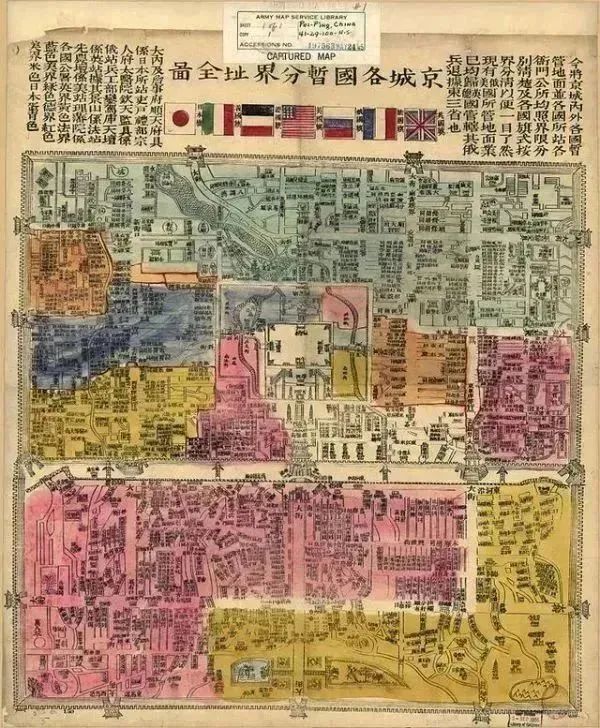
Scholars queuing up to enter the Humboldt Forum
Why did Germany actively trace and plunder cultural relics?
In recent years, European society, especially Germany, has been reflecting on colonial history. Although Germany was later in global expansion than other European powers, before World War I, it had become the third largest colonial empire after Britain and France, with colonies spread throughout Africa, the South Pacific, and the Jiaozhou Bay in China.
In the German media, there is an increasing call to examine colonial history, which is the result of years of protests by African American civil rights organizations and left-wing scholars in Germany. They demanded that streets named after colonizers be renamed, and demanded that German states incorporate colonial history into their school curriculum.
The death of African American George Floyd further triggered reflection on racism and colonial history in German society. This shift in social attitudes has also been reflected at the policy level. The new German government promised to pay more in-depth attention to colonial history in the political party alliance agreement at the beginning of taking office.
As a venue for collecting global cultural relics, German museums have also become the main battlefield of public opinion.
In September 2021, the Humboldt Forum Museum project in Germany, which took 20 years and cost 680 million euros, was opened to the public. The building of the Humboldt Forum was originally the palace of German Emperor Wilhelm II, who had great colonial ambitions. It was under his leadership that Germany leapt to become a colonial power. The Humboldt Forum, as an exhibition hall of the National Museum and the Asian Art Museum, houses a large collection of colonial artifacts looted from around the world. Although the Humboldt Forum project initially aimed to shape Berlin's image as a world cultural center, its close connection with colonial expansion has become a controversial focus of reflection on colonial history.
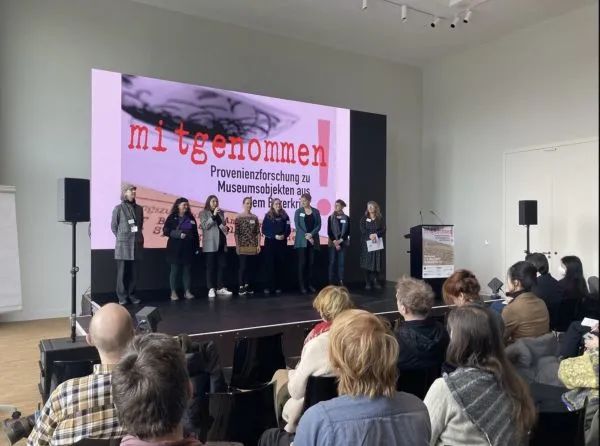
In recent years, many German museums have had to start examining their collections due to protests and push from former colonial countries, especially African countries. At present, a small portion of the collection, such as Benin bronze artifacts and the remains collected by Germany after the massacre in Namibia, have been returned to their original countries.
It is worth mentioning that due to Africa being the main stage of German colonial activities, the current discussion of colonial history in German society is mainly focused on Africa, and Germany's colonial behavior in China is rarely known.
Kristen Howard, the initiator of the Boxer Rebellion Cultural Relics Traceability Project, said in an interview with a special contributor to The Paper, "The traceability work of cultural relics in German museums mainly focuses on African relics, which is undoubtedly very important. However, China has also experienced a cruel colonial history. As an Asian art expert, I believe that Germany should give equal attention to research in this area."
She emphasized that the tracing of cultural relics during the Boxer Rebellion period is still in its early stages, and the issue of cultural relic return goes beyond the scope of cultural relic tracing work, involving areas such as museum policy and diplomacy. However, if it is determined that these cultural relics were illegally looted by German colonizers, she believes that these relics should be returned. She said, "At least we should be able to openly discuss the future of these cultural relics. From my personal perspective and the perspective of a cultural relic tracing worker, I hope these items can be returned to China in the future."
Ms. Kristen Panhorst, the project research assistant and coordinator, said, "These artifacts are in the storage room of our museum, and we have a responsibility to ask ourselves, 'How did they come from? Is it suitable here? If not, what should we do?'"
Experts from the Tresden Museum in Germany introduce the Purple Light Pavilion Merit Map, which appears to be looted, in the museum
150 German speaking experts discuss the cultural relics of the Boxer Rebellion
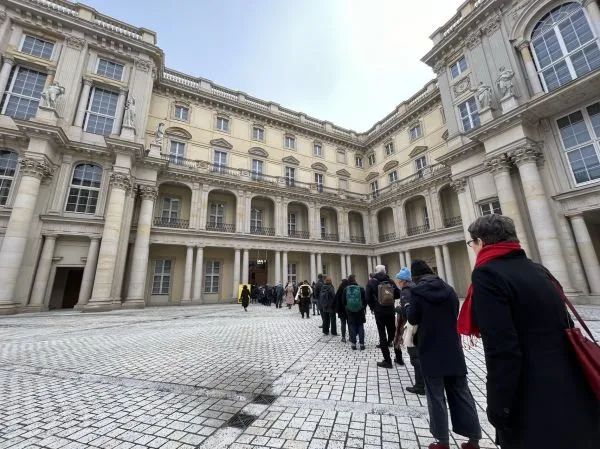
In March of this year, a two-day workshop was held at the Humboldt Forum, organized by the tracing group "Tracking Boxer Cultural Relics". It attracted 150 curators, art history experts, sinologists, and historians from the German speaking world to jointly explore the issue of Germany stealing artworks in China during the suppression of the Boxers. Experts presented some suspicious cultural relics in their museum collection and discussed the questions and difficulties they encountered in their research.
Panhorst explained that they specifically opened the seminar to the public: "Because compared to history, these artworks are things that people can truly see and touch, and are a way to understand colonial history."
German sinologist Peggot stated at the meeting that 1900 was a crucial year for Chinese artifacts in German museums, just as 1933 was an important milestone for the Nazi plunder of Jewish art. "Any Chinese cultural relic that entered German museums after 1900 must have its source reviewed."
Susan Nordl, the curator of the MARKK Museum in Hamburg, previously told the author that since 1900, the museum's Chinese artifacts have significantly increased in both quality and quantity, which has raised doubts about the origin of these collections. With the support of the new director for tracing and returning in 2017, Kn ö del began to conduct systematic statistics on suspicious cultural relics.
The Boxer Rebellion began in Shandong Province and quickly spread to various parts of northern China. During this period, the German ambassador to China, Clyde, was killed by Qing Dynasty soldiers, which became the trigger for the Eight Nation Alliance to jointly send troops to suppress the Boxer Rebellion. Pei Gaode estimated at the seminar that Emperor Wilhelm II sent a total of 20000 soldiers to China. When bidding farewell to these expeditionary forces, he delivered the infamous "Xiongnu Speech": "Leave no prisoners of war, kill to death. Just like the Xiongnu people under the command of King Ezel thousands of years ago who still held great power in the legend that has been passed down to this day, Germany's influence should also spread throughout China, so that no Chinese person will dare to look down on the Germans."
However, by the time these German soldiers arrived in China, most of the war had already ended. Pei Gaode said, "Germany has just caught up with the carnival of the winners dividing the spoils. German soldiers can put whatever they plunder into their pockets."
The Old Shadow of the Eight Nation Alliance during the Invasion of China

The Old Shadow of the Eight Nation Alliance during the Invasion of China
The plunder by soldiers from various countries has flooded the streets and alleys of Beijing with palace art, and German museums have also dispatched personnel to Beijing to purchase cultural relics. According to the research of art historian Lefrenz, the Berlin Museum of Nationalities sent Assistant Director Muller to Beijing in 1901. Although he only received 10000 marks in funding, through his relationship with the German army, he obtained a batch of cultural relics at a low price, sometimes even for free. According to records, Muller sent a total of 117 wooden crates of cultural relics back to Berlin. During his time in Beijing, he purchased two statues of meritorious figures from the Purple Light Pavilion, and after returning to China, he also purchased a large number of statues from German soldiers.
According to Lefrenz's research, most of the existing Ziguangge artworks were once housed in museums in Germany. However, Germany experienced two World Wars, and many cultural relics and documentary records were destroyed. After the end of World War II, during the Soviet occupation of Berlin, a large number of collections in German museums were transferred as spoils of war to St. Petersburg. It is currently unclear how many Chinese cultural relics were destroyed or scattered to the Soviet Union.
There are numerous challenges in confirming the source of cultural relics
It is not easy to determine the source of a large number of lost cultural relics, and there are not many cases that can be clearly defined as plundering cultural relics, such as the Ziguang Pavilion hero statue. Confirming the origin of cultural relics requires a high level of professional skills and knowledge, involving multiple fields such as art history, archaeology, sinology, and materials science, which requires a lot of time and resources.
Project leader Howard believes that Germany sometimes lacks expertise in identifying artifacts. "Some Chinese experts can provide a lot of information about the background and authenticity of cultural relics by picking up a cup and seeing whether it is light or heavy." She hopes that through cooperation with experts from the Palace Museum, she can help the research of the cultural relics themselves. German experts can only find clues from German archives, and sometimes find out who sold the cultural relics to museums, but whether the cultural relics left China through legal channels still needs further research. In this regard, Germany also hopes to share more information with China.
On the other hand, the background of cultural relics from the late Qing Dynasty was extremely complex. After Beijing was occupied, in addition to the plundering and plundering by the Eight Nation Alliance, there were also Chinese civilians who took advantage of the chaos and looted. The economic situation of the imperial family in the late Qing Dynasty was deteriorating day by day. In order to maintain a standard of living, data shows that Puyi and other members of the royal family sold a large number of cultural relics, and even palace maids and eunuchs privately sold treasures in the palace. It is not easy to determine whether a cultural relic was really stolen by Germans.
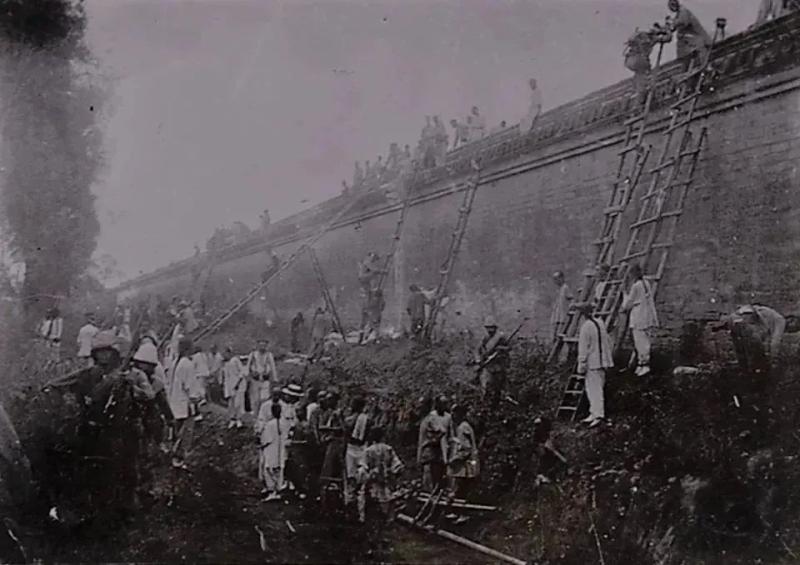
"Of course, this was all done in the context of colonialism. If Britain had not forcibly opened the door to China in the mid-19th century and countries began to sign unequal treaties with China, China would not have fallen into that political, social, and economic predicament," Howard believed. She added, "We are unable to confirm the origin and migration path of each item, which requires researchers to classify which are confirmed looted, which are suspicious, and which are safe and legal cultural relics."
In response to the complex historical background of the colonial period, the German Museum Association has published a guide to provide advice and assistance for museums to store colonial collections. This guide suggests that under the unequal rights relations brought about by colonialism, if it can be proven that cultural relics were obtained through improper means and the country of origin has made a request for return, Germany is recommended to return these cultural relics. At this point, the traceability of cultural relics plays an important role. Of course, this guide is not legally binding. Some critics believe that due to the lengthy process of tracing cultural relics, it may be used as an excuse by some museums to delay and become a stumbling block to the return of cultural relics.
The researcher of the Boxer Rebellion Cultural Relics project stated that so far, their museum has not received any claims from the Chinese side.
Professor Huo Zhengxin from the School of International Law at China University of Political Science and Law stated that existing international law does not provide sufficient protection for cultural relics lost in China in the early 20th century. "From the current legal perspective, it is not easy for China to recover cultural relics from this period, but Germany's behavior at that time was definitely immoral. From an emotional and moral perspective, return is also necessary. It really depends on the extent to which the Germans themselves want to achieve it."
He suggested that China should utilize the process of European reflection on colonial history, actively select representative cultural relics, and negotiate with Germany through communication, cooperation, and diplomatic coordination to explore whether it can facilitate the return of Chinese cultural relics.
The voices of German society are diverse
Germans have limited understanding of Germany's colonial history in China, and not everyone who understands it supports criticizing this period of history. German sinologist Frank published an article in German media criticizing the "Boxer Cultural Relics Traceability" project. She wrote, "China has never become a colony ruthlessly exploited by Western powers like some African countries. Chinese people have neither lost all their cultural heritage nor lost their identity due to defeat."
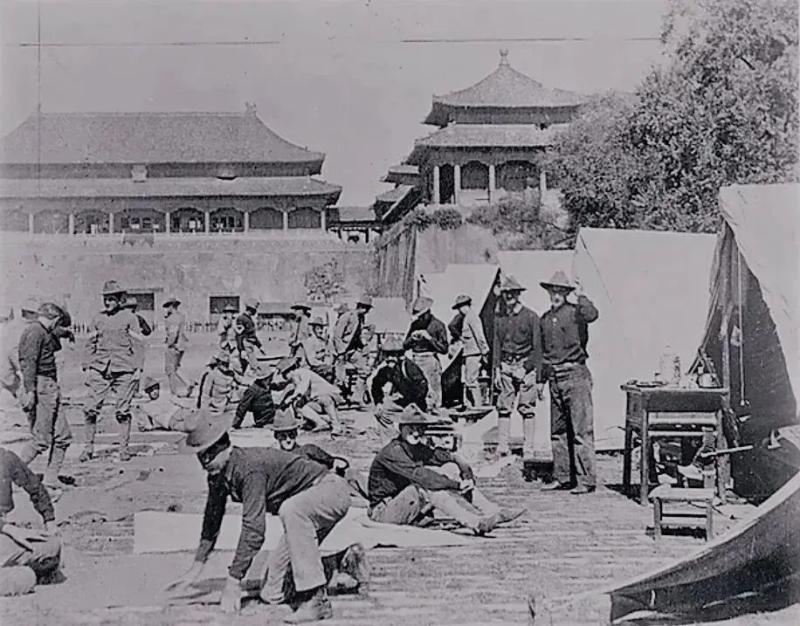
Ms. Frank is the granddaughter of Otto Franke, the founder of German Sinology, and her mother is Chinese. She believes that China has a long tradition in the art market, and calls the Chinese art in her home a legal purchase. She also claimed that the overseas circulation of Chinese cultural relics played an important role in the West's understanding of Chinese culture, so it should not be completely denied that the cultural relics of this period, and large-scale traceability work is a waste of resources. "Chinese people have no demand for the return of cultural relics. Germans' false sense of self blame and eagerness to return them are not conducive to active cultural mediation and international understanding."
In response, Howard also wrote an article acknowledging that not all cultural relics from China are obtained through illegal or unethical methods. The key is to conduct detailed research on their sources. She wrote: "In the study of the origin of cultural relics, we must not only reconstruct the path of art, but also question the behavior of our predecessors." She believes that public institutions such as museums have a moral obligation to inspect their collections. The "Tracking Boxer Relics" project plans to hold an international seminar in English in early 2024, hoping to attract more Chinese and global researchers to participate. At the end of the project, the research team will develop a guide that other museums will provide as a basis for their research into Boxer artifacts. The researchers hope that the Palace Museum will be involved in writing the guidelines to ensure that Chinese voices and perspectives are included.
Considering the complexity and time-consuming process of tracing cultural relics, as well as the lack of a strong legal framework on the German side, the possibility of Germany returning cultural relics from the Eight Nation Alliance's invasion of China in the coming years is relatively low. However, should German museums continue to display cultural relics that are clearly identified as plundered?
Several curators at the seminar gave positive answers to the author's question. They believe that presenting these controversial cultural relics in the exhibition is valuable and can be used to introduce tourists to this forgotten history. Curator Augustine of the Berlin Museum of Asian Art said, "This history is the history of the artwork itself, the history of the collection, and also the history of our museum. It should be made more obvious to visitors."
Of course, this concept is also quite controversial. Some people believe that continuing to display these cultural relics in museums is also a continuation of plundering behavior, which is disrespectful to the country where the cultural relics originally belonged. This issue involves balancing multiple interests and values, making it difficult to find a universally recognized correct approach. At present, some museums have adopted a joint curation approach with experts and communities from the countries of origin of cultural relics, which is conducive to eliminating the single European perspective in the exhibition narrative, leaving the discourse power to the countries of origin of cultural relics, reflecting respect and balance for cultural diversity, and allowing audiences to better understand the original cultural significance of cultural relics.




